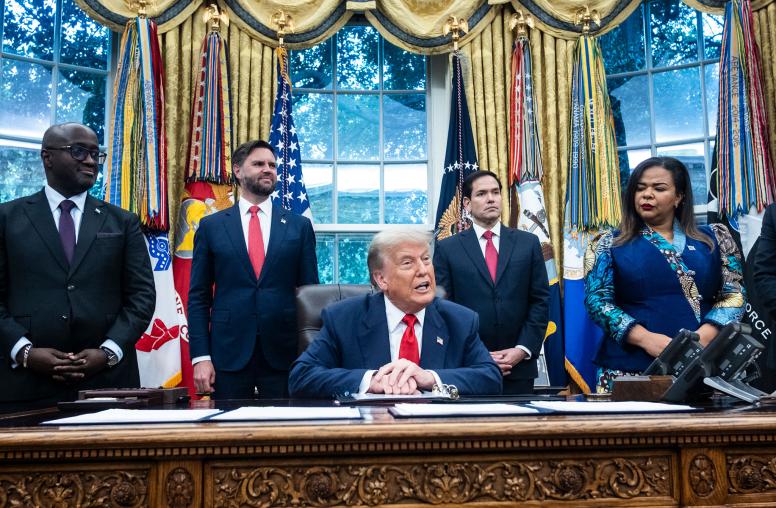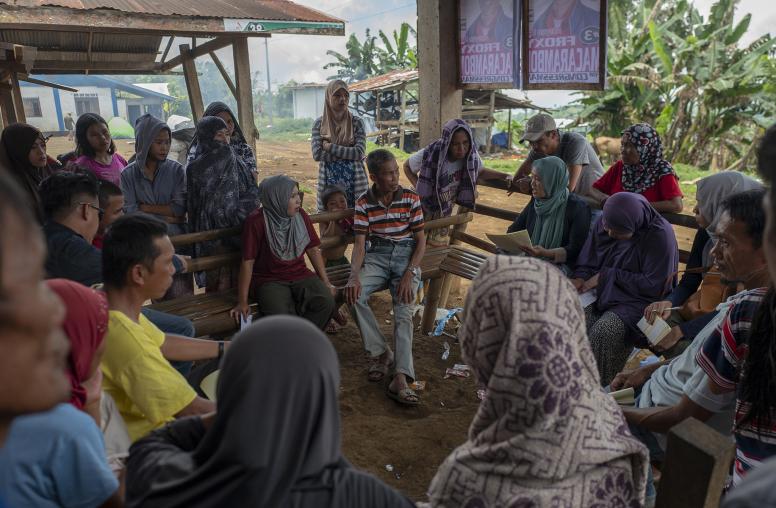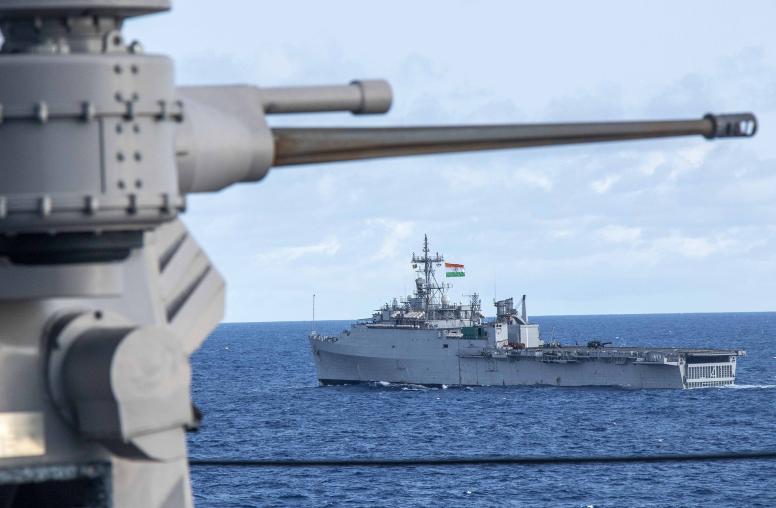2006-2007 Winning Essay
National First Place Winner
Wendy Cai
Corona Del Sol High School
Tempe, Arizona
Coordinator: Virginia Teeples
In 2002, United Nations (UN) Secretary-General Kofi Annan solemnly declared, "To accept the use of child soldiers in conflict is to accept the destruction of our future, one child at a time... we must reclaim them—every one of them."1 It is critical to understand the legacy of child soldiering and its implications for peacebuilding in order to help young soldiers rejoin civil society. Today, based on case studies of Sierra Leone and Uganda, we, the UN task force, shall develop a holistic reintegration program that fosters reconciliation through harmonious interaction between ex-child soldiers and their communities, addresses education with youth participation, and collectively empowers the war-torn communities towards lasting peace.
The conflict in Sierra Leone stemmed from its post-colonial societal crisis. Despite numerous coups, each successive Freetown regime was guilty of corruption and misgovernance.2 This institutional collapse eventually reduced the vast majority of the populace into a state of deprivation and political exclusion, creating fundamental grievances.3 As expelled citizens increasingly perceived bloodshed as legitimate, "it required only the slightest spark for this violence to be ignited."4
The civil war broke out in 1991 when the Revolutionary United Front (RUF) fought against the Sierra Leone Army (SLA). Without a social change program, the unpopular RUF perpetuated the war through resource exploitation and human rights atrocities. When "sobels"—SLA soldiers by day and brutal RUF rebels by night—emerged, the destructive chaos embroiled all other warring parties in a cruel pursuit for wealth.5 To the RUF, defeating the SLA was less important than controlling diamond mines.6 The diamond-driven war economy fueled the RUF with drugs that facilitated human exploitation—including child soldiering.7
Children played multiple roles in the RUF’s terror campaign. Youths, abducted or induced into the army, composed 80 percent of the RUF.8 Stigmatized, the abductees were forced to perpetrate heinous crimes against their own families and communities. Indoctrination and "brown-brown" drugs transformed children into fearless fighting machines.9 Serving as human shields, cooks, porters, or diamond miners, children were perceived as cheap and disposable resources.10 Girls often suffered sexual abuses, becoming "bush wives."11 Many of them had "bush kids" when the war ended in 2001.12
The war in Uganda arose from deep-rooted causes. Ethnic and regional division under British colonization created a historical mistrust between the Acholi-dominated tribes in the north and the communities in the south.13 Viewing the north as a "hostile and disturbed" region, each post-colonial southern regime further repressed the Acholi, eventually eliminating their sense of national identity.14 Meanwhile, Uganda’s militarized political system cultivated a culture of violence, impunity, and vengeance.15 Thus, armed rebellion against a regime was deemed "a normal course of political business."16
In 1986, a civil war erupted in the north with the goal of overthrowing President Yoweri Museveni. In 1987, Joseph Kony established the Lord's Resistance Army (LRA) to combat Museveni’s Ugandan People’s Defense Force (UPDF). With no clear political agenda, Kony directed the LRA with a cult-like mentality. As Acholi grassroots support waned, the LRA shifted the focus of the fighting from the UPDF to its own kinfolks. With Sudanese logistics support, the LRA has since sustained the war through child abduction and inculcating a belief in the spiritual powers of its violent leader.17
In northern Uganda, child soldiering has military, ethnic, and spiritual implications. Children, ninety percent of the LRA force, serve as soldiers, laborers, and sex slaves.18 From Kony’s perspective, the children of "wives" and his male soldiers are pure Acholi and will inherit his "spiritualism."19 Inventing a "religious cocktail" that combines Christianity, Islam, and indigenous beliefs, Kony speciously vindicates atrocities—mutilation, arson, sex slavery, and murder.20 Through religious rituals and indoctrination, the LRA leaders have enslaved children with fear, shaping them into effective weapons against the UPDF and civilians. Today, the tragedy still continues.
In both Sierra Leone and Uganda, the impact of warfare on young soldiers is devastating. Indelibly scarred, one RUF child soldier bewailed, "I was branded [RUF]... [I] can’t run away myself. Evil is with me all the time..."21 Deprived of their innocence and of affection and education, child soldiers suffer severe disruption in their physical, mental, and moral development. Psychosomatic disturbances are among the most serious after-effects. In Uganda, "some children sit and look at running water and just see blood."22 Moreover, the trauma has distorted their identity and values. One Sierra Leone observer commented, "You won’t believe how isolated they are. They are asking what will happen to them if there is peace. They don’t know life without a gun."23 Family rejection and community hostility only exacerbate this situation. Unless appropriate countermeasures are taken, former young soldiers will reenter a realm of crime or violence.
To address this challenge, international and local communities have delivered programs to help them rebuild a civilian life. In Sierra Leone, for instance, Christian Children’s Fund (CCF) implemented a community-based program in North Province.24 While involving community leaders in selecting a construction project, the CCF held dialogue sessions exploring how to accept returning young soldiers. The discussion gradually opened the doors for forgiveness through traditional nonviolent conflict resolution, emphasizing children’s suffering as soldiers. In the next stage, ex-child soldiers and other youths collaborated on the project, gaining a sense of cooperation and mutual understanding. This tangible construction process changed community members’ hostile attitudes. Experiencing an increased confidence, community chiefs eventually advanced reconciliation via traditional rituals and moral tutelage. Finally, forgiven children received market-justified training in carpentry, tailoring, or tie-dyeing. Youths worked under the direction of a master who was also a mentor and moral guide to teach them how to behave in peaceful settings. Afterwards, micro-credit helped them to start up their businesses.
The program, initially implemented in fifteen communities, was then expanded to other areas, enjoying considerable success in terms of a remarkable reduction in criminality and increased reintegration of ex-child soldiers into their villages.25 By 2003, 90 percent of former young soldiers in those areas had rejoined their communities.26
In 2004, a group of former LRA girls established an organization called Empowering Hands (EH) to support each other in Uganda’s Gulu District. Instead of lamenting their hardships, these young women have utilized the skills acquired from the bush—such as midwifery and leadership—to develop income-generating programs.27 To assist other women going through the reintegration process, they encourage their peers through support groups and share their experiences on radios.28 As the support groups have expanded from five to twenty, EH currently works on a funding plan to help them develop their own businesses.29
The CCF program in Sierra Leone is systematic and educational. Peace education is woven into program components to nourish a harmonious interaction between youth and community. The Ugandan EH initiative, on the other hand, is plain but strongly participative in terms of youth leadership. Both programs have a common focus on income-generating activities. Structurally, however, they lack durable psychosocial and empowerment components, given the aftermath of child soldiering. Meanwhile, recent research reveals that reintegration represents one of the greatest opportunities to break out of the cycle of violence and hatred.30 This implies that peace education may achieve its best effect if implemented in a more active way.
Therefore, we propose a holistic program—Harmony-Oriented Participation and Education (HOPE)—that emphasizes youth participation, comprehensive education, and enhanced psychosocial support. Targeting the whole community, HOPE contains four components. Firstly, program management ensures HOPE’s success. It mainstreams HOPE among UN agencies, donors, and other stakeholders and establishes baselines and partnerships. Consulting with community leaders and youth representatives, management staff formulates a custom HOPE Curriculum that covers basic education, peace education, human rights advocacy, training, and psychosocial support. HOPE indicators—such as reintegration rate and youth crime rate—are used to evaluate progress and determine success.
Secondly, reconciliation facilitation fosters community reconciliation. It sponsors ex-child soldiers to seek forgiveness through their own proposals. Peace education, outreach, exchange, and traditional culture play an active role in renewing family and communal relations.
Thirdly, competence centers implement HOPE curricula to empower ex-child soldiers and other community members through courses, workshops, and other educational events. Based on market analyses and community development requirements, vocational training links livelihood opportunities. Encouraging youth participation in community governance, these centers endorse youth-group activities. A fund called HOPE Entrepreneurship and Leadership Promotion (HELP) supports job creation and civil society reconstruction initiatives. Furthermore, HELP may be used as an incentive to reinforce peace education.
Lastly, psychosocial assistance aids war-affected children to rebuild identity, self-esteem, value, and trust. It strengthens rehabilitation by galvanizing children to organize and participate in recreational and educational activities. Paying special attention to young women, it constructs a three-year psychosocial support network with follow-up and check-back services as suggested by Graça Machel.31
While the legacy of child soldiering challenges peacebuilding, youth reintegration creates a window of opportunity to reshape war-ravaged societies with a culture of peace, reconciliation, and cooperation. HOPE establishes an interactive platform that unifies and empowers the entire community towards a harmonious and self-sustaining society. By promoting peace education and youth participation, HOPE enables young generations to become both productive constructors and peace-torch carriers.
Endnotes
1. "Annan Calls for Action to End 'Despicable' Practice of Conscripting Children." UN New Center. 7 May 2002. UN News Service. 12 Dec. 2006 http://www.un.org/apps/news/storyAr.asp?NewsID=3608&Cr=child&Cr1=soldiers&Kw1=mtv&Kw2=&Kw3=.
2. "Witness to Truth: Report of Sierra Leone." Truth and Reconciliation Commission. Sierra Leone, Vol 1. (GPL Press, Accra, Ghana, 2004), p. 10.
3. Ibid.
4. Ibid.
5. Doygherty, B. K. Right-sizing International Criminal Justice: The Hibrid Experiment at the Special Court for Sierra Leone. International Affairs Vol 80 (2002), p. 315.
6. Harden, Blaine. "Africa’s Gems: Warfare’s Best Friend." New York Times. 6 April 2000.
7. Ibid.
8. "Children of the Gun." Children in Crisis Project Report. September 2000. Save the Children. 4 Jan. 2007 http://www.savethechildren.org/crisis.
9. Zarifis, Ismene. Sierra Leone’s Search for Justice and Accountability of Child Soldiers. Human Rights Brief 9, No. 3 (Spring 2002): pp. 18, 21.
10. Singer, P.W. Children at War. (New York: Pantheon Books, 2005), p. 106.
11. Singer, p. 105.
12. "Restoring Lost Childhood in Sierra Leone." Oct. 2001. Africa’s Recovery. 24 Jan. 2007 http://www.un.org/ecosocdev/geninfo/afrec/subjindx/childpdf/childso2.pdf.
13. Lomo, Z and Hovil, L. "Behind the violence: Causes, consequence and the search for solutions to the war in Northern Uganda." Refuge Law Report. Kampla, Uganda. 2004.
14. Ibid.
15. "Behind the Violence." Refugee Law Project Working Paper, No. 11. Feb. 2004, p. 7.
16. Ibid.
17. "Pawns of Politics: Children, Conflict and Peace in Northern Uganda." Field Report. 2004. World Vision. 8 Jan. 2007 http://www.childrights.org/PolicyAdvocacy/pahome2.5.nsf/
0/49B263F8D988FD6488256F1C004C960A/$file/Pawns_Of_Politics.pdf.
18. Ibid.
19. Kavuma, Richard. "Tears of a Child Mother." The Monitor. 15 April, 2004.
20. "Pawns".
21. Harman, Danna. "Aid Agnecies to Rid Child Soldiers of War’s Scars." Christian Sceince Monitor. 30 Oct. 2001.
22. Singer, p. 195.
23. Farah, Douglas. "Sierra Leone Rebels Contemplate Life Without Guns." Washington Post. 14 April, 2001.
24. Wassels, Michael. "Child Soldiers, Peace Education and Postconflict Reconstruction for Peace." Theory into Practice, 44(4), p. 363, 369.
25. Ibid.
26. Ibid.
27. Baines, Erin at el. "War-Affected Children and Youth in Northern Uganda: Toward a Brighter Future." May 2006. Assessment Report. 5 Dec. 2006 http://www.macfound.org/atf/cf/{B0386CE3-8B29-4162-8098E466FB856794}/UGANDA_REPORT.PDF.
28. Hapwood, Julian, "Journal Letter." Dec. 2006. Quaker Peace & Socil Witness. 27 Jan. 2007
29. Ibid.
30. Rippon, Thomas and Willow, Stan. "Sierra Leone: A Model for a Program for Action for a Culture of Peace". OJPCR , Issue 6.1 2004. Tabula Rasa Institute. 10 Dec. 2006 http://www.trinstitute.org/ojpcr/6_1ripwil.htm.
31. Machel, Graca. "The Impact of Armed Conflict on Children." International Conference on War-affected Children. September 2000. Winninpeg, Canada. 6 Dec. 2006 http://www.unifem.org/filesconfirmed/97/137_machelrep.pdf.
Works Cited
Primary Sources:
"Behind the Violence." Refugee Law Project Working Paper, No. 11. Feb. 2004.
Doygherty, B. K. Right-sizing International Criminal Justice: The Hibrid Experiment at the Special Court for Sierra Leone. International Affairs Vol 80 (2002), p. 315.
Farah, Douglas. "Sierra Leone Rebels Contemplate Life Without Guns." Washington Post. 14 April, 2001.
Harden, Blaine. "Africa’s Gems: Warfare’s Best Friend." New York Times. 6 April 2000.
Harman, Danna. "Aid Agnecies to Rid Child Soldiers of War’s Scars." Christian Sceince Monitor. 30 Oct. 2001.
Kavuma, Richard. "Tears of a Child Mother." The Monitor. 15 April, 2004.
Lomo, Z and Hovil, L. "Behind the violence: Causes, consequence and the search for solutions to the war in Northern Uganda." Refuge Law Report. Kampla, Uganda. 2004.
Singer, P.W. Children at War. (New York: Pantheon Books, 2005.
Wassels, Michael. "Child Soldiers, Peace Education and Postconflict Reconstruction for Peace." Theory into Practice, 44(4).
"Witness to Truth: Report of Sierra Leone." Truth and Reconciliation Commission. Sierra Leone, Vol 1. (GPL Press, Accra, Ghana, 2004).
Zarifis, Ismene. Sierra Leone’s Search for Justice and Accountability of Child Soldiers. Human Rights Brief 9, No. 3 (Spring 2002).
Internet Sources:
"Annan Calls for Action to End 'Despicable' Practice of Conscripting Children." UN New Center. 7 May 2002. UN News Service. 12 Dec. 2006 http://www.un.org/apps/storyAr.asp?NewsID=3608&Cr=child&Cr1=soldiers&Kw1=mtv&Kw2=&Kw3.
Baines, Erin at el. "War-Affected Children and Youth in Northern Uganda: Toward a Brighter Future." May 2006. Assessment Report. 5 Dec. 2006 http://www.mac-found.org/atf/cf/{B0386CE3-8B29-4162-8098E466FB856794}/UGANDA_REPORT.PDF.
"Children of the Gun." Children in Crisis Project Report. September 2000. Save the Children. 4 Jan. 2007 http://www.savethechildren.org/crisis.
Hapwood, Julian, "Journal Letter." Dec. 2006. Quaker Peace & Socil Witness. 27 Jan. 2007 http://www.quaker.org.uk/Templates/Internal.asp?NodeID=93067.
Machel, Graca. "The Impact of Armed Conflict on Children." International Conference on War-affected Children. September 2000. Winninpeg, Canada. 6 Dec. 2006 http://www.unifem.org/filesconfirmed/97/137_machelrep.pdf.
"Pawns of Politics: Children, Conflict and Peace in Northern Uganda." Field Report. 2004. World Vision. 8 Jan. 2007 http://www.childrights.org/PolicyAdvocacy/pahome2.5.nsf
/0/49B263F8D988FD6488256F1C004C960A/$file/Pawns_Of_Politics.pdf.
"Restoring Lost Childhood in Sierra Leone." Oct. 2001. Africa’s Recovery. 24 Jan. 2007 http://www.un.org/ecosocdev/geninfo/afrec/subjindx/childpdf/childso2.pdf.
Rippon, Thomas and Willow, Stan. "Sierra Leone: A Model for a Program for Action for a Culture of Peace". OJPCR , Issue 6.1 2004. Tabula Rasa Institute. 10 Dec. 2006 http://www.trinstitute.org/ojpcr/6_1ripwil.htm.




